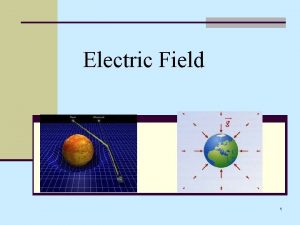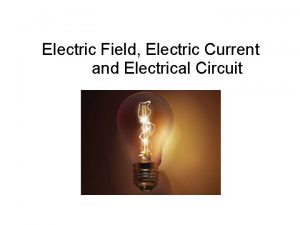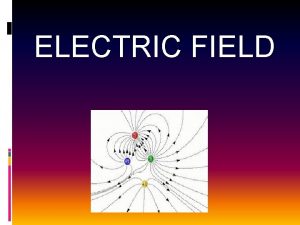Electric Field FIRDIANA SANJAYA4201414050 ANA ALINA4201414095 Electrical Field









- Slides: 9

Electric Field FIRDIANA SANJAYA(4201414050) ANA ALINA(4201414095)

Electrical Field The electric field a distance r away from a point charge is given by: The electric field from a positive charge points away from the charge; the electric field from a negative charge points toward the charge.

Like the electric force, the electric field E is a vector. If the electric field at a particular point is known, the force a charge q experiences when it is placed at that point is given by : F = q. E If q is positive, the force is in the same direction as the field; if q is negative, the force is in the opposite direction as the field.

Learning from gravity Gravitational field has a magnitude of 9. 8 m/s 2 and points straight down. If you threw a mass through the air, you know it would follow a parabolic path because of gravity. You could determine when and where the object would land by doing a projectile motion analysis, separating everything into x and y components. You can do the same thing with charges in a uniform electric field. If you throw a charge into a uniform electric field (same magnitude and direction everywhere), it would also follow a parabolic path. The one big difference between gravity and electricity is that m, the mass, is always positive, while q, the charge, can be positive, zero, or negative.


The field around a charged conductor A conductor is in electrostatic equilibrium when the charge distribution (the way the charge is distributed over the conductor) is fixed. Basically, when you charge a conductor the charge spreads itself out. At equilibrium, the charge and electric field follow these guidelines: the excess charge lies only at the surface of the conductor the electric field is zero within the solid part of the conductor the electric field at the surface of the conductor is perpendicular to the surface charge accumulates, and the field is strongest, on pointy parts of the conductor

Electric flux The electric flux is equal to (E cos ) A, where is the angle between the electric field and the normal (the perpendicular) to the surface.

Permittivity What is the permittivity of free space? It's a constant related to the constant k that appears in Coulomb's law. The relationship between the two is this:

Gauss’ Law Gauss' Law is a powerful method of calculating electric fields. If you have a solid conducting sphere (e. g. , a metal ball) that has a net charge Q on it, you know all the excess charge lies on the outside of the sphere. Gauss' law tells us that the electric field inside the sphere is zero, and the electric field outside the sphere is the same as the field from a point charge with a net charge of Q.
 Chapter 21 electric charge and electric field
Chapter 21 electric charge and electric field Electrostatic field formula
Electrostatic field formula Chapter 21 electric charge and electric field
Chapter 21 electric charge and electric field Joules per coulomb
Joules per coulomb Chapter 21 electric charge and electric field
Chapter 21 electric charge and electric field Potential energy of capacitor
Potential energy of capacitor K constant unit
K constant unit Electric field from electric potential
Electric field from electric potential Gauss law of magnetism
Gauss law of magnetism Distinguish between magnetic and nonmagnetic materials
Distinguish between magnetic and nonmagnetic materials

















